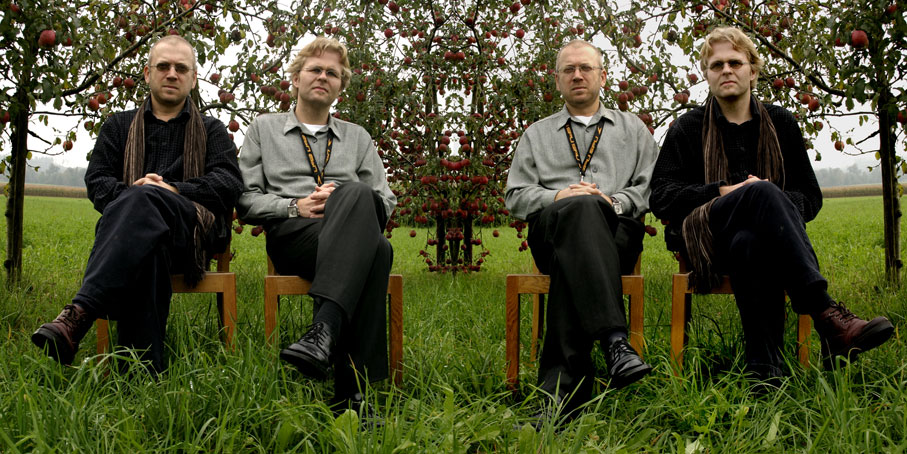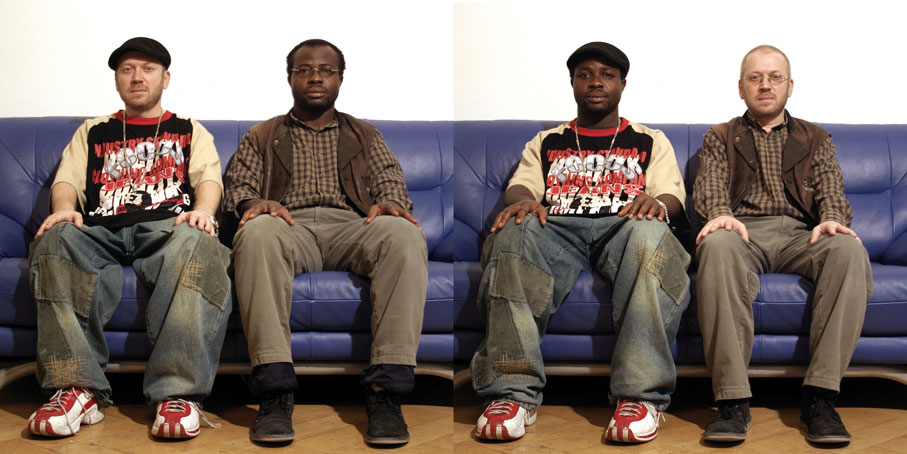
Bartha & Kielmayer
Oliver Kielmayer:
Többszörös személyiség – Bartha József dupla-képei
Bartha József: Doubled images. I’m always someone else
Galeria Noua, Bukarest, 2005. július 13 – 31.
Liget Galéria, Budapest, 2006. január 12 – február 2.

Bartha & Kielmayer
Bartha József munkáiban fontos szerepet játszanak a társadalmi és individuális identitásképzés mechanizmusai, illetve stratégiái. Marlboro Country (2003) és Recycling (2004) című műveiben például arra a jelenségre mutat rá, miszerint önmagunk kifejezése és megvalósítása manapság gyakran különböző fogyasztási cikkekkel kapcsolódik össze, melyekben a szabadság és az individualizmus csupán reklámfogásként van jelen. A Marlboro Country-ban szünet nélkül füstölt cigaretták, csakúgy, mint a használt női harisnyák, amikből a Recyclingban egy asszony új párat köt magának, gyárilag előállított tömegtermékek. Bár az egyiket a másik cigaretta után szívó férfiak köre kimondottan derűs, vidám „cowboy-hangulatot” közvetít, az eszme pedig, hogy egy, már a szemétre dobott használati cikkből még egyszer valami szép születhetik, mindenképpen hordoz pozitív gondolatokat, mégis: mindezekkel párhuzamosan az emberiség rabszolgasorba való süllyedését ábrázolja, légyen szó függőségről, avagy szépség-rögeszméről.
2003-ban Bartha Doubled images. I’m always someone else címmel kétrészes fotómunkák sorozatát kezdte meg, melyeken ugyanazokat a szereplőket fényképezte; az egyik képen azonban a szereplők a másik ruháját és tartását veszik át. Van olyan kép is, ahol a képek közül az egyik utólagosan tükröződik vissza, minek következtében minden, egészen a szereplők arcáig, teljes mértékben a tükörképeknek felel meg. Bartha alapos pontossággal alkotja meg a képeket, egyfajta optikai visszacsatolási effektust hoz létre, a képi információk egymással való keresztezése pedig állandósult oszcillációkká alakul át.
Az egyszerű ruhacsere által válik világossá: az emberekről alkotott képünket nagy mértékben a külsőségek alakítják. Az öltözködés régóta több annál, mint testünk egykori praktikus-szükségszerű befedése, segítségével egyéniségünk, karakterünk és világszemléletünk jut kifejezésre. Leginkább a nyugati fogyasztói társadalmakban alakult ki megannyi lehetőség az öltözködés általi egyéni kifejezésnek, az elmúlt időben pedig a stílusok legkülönbözőbb palettája sorakozott fel. A globalizmus-ellenes, a csajszis, az üzletember, a deszkás, az individualista, a kokott avagy a sportos megjelenés csupán néhány példa a sok közül, amikhez majd folyamatosan újak és újak csatlakoznak még.
Az öltözködés és a külső jelzők mindenkor felcserélhető individuális mivolta mellett Bartha képei ugyanakkor valami másra is felhívják a figyelmünket. Nem csupán játékos próbálgatásról, a különböző öltözetek kontextusfüggő, s az azzal kapcsolatos viselkedések felcserélgetéséről van szó, hanem arról, hogy ruhák felcserélésével hirtelen több, mint két ember lesz látható – élettörténetek, melyek az öltözködés és a külső attribútumok segítségével, a ruházattól a viselkedésig leírhatóvá vállnak. Az a kérdés pedig, hogy melyik öltözék eredetileg melyik személyhez tartozik, nem annyira érdekes, mint az, hogy belássuk, tulajdonképpen mindkét variáció lehetséges. Más személyek bizonyos attribútumai átvételével a szereplők részben saját maguk is transzformálódnak, amit aztán meg is próbálnak közvetíteni: személyes élettörténetük fejlődése közel sem annyira szigorú momentum és magától értetődő, mint ahogy azt gondolná az ember. Az emberi élet nyitott marad a születésnél – erre próbál rámutatni Bartha –, mi pedig életünk végéig magunkban hordozzuk a vágyat, hogy valaki más lehessünk. Ezzel pedig ismét egy ígérethez érkeztünk, miszerint nem fáradhatunk bele saját világunkba, hisz az folyvást újat és újat hoz a számunkra.
Képeivel Bartha ezen mechanizmusokat mutatja meg nekünk. A Doubled images szuggerálta felcserélhetőség és véletlenszerűség érdekes következménye, hogy nem létezik semmiféle értékelés, ugyanis mindenki a mechanizmusok része. Művészként Bartha egy kalap alá veheti szereplőit. Emberként viszont ő is csupán egy véletlenszerű élet megtestesítője, ami más körülmények között akár egészen másként is alakulhatott volna.
.
Oliver Kielmayer:
I am always another (Doubled images)
Bartha József: Doubled images. I’m always someone else
Galeria Noua, Bukarest, 2005. július 13 – 31.
Liget Galéria, Budapest, 2006. január 12 – február 2.
József Bartha has been working on the series Doubled Images since
2003. There are two persons in the pairs of photographs. The images are
each other’s reflections and the models exchange their outfits from one
image to the other. At first glance one might not notice any difference
among the photos, especially between the pairs, since everything – even
the different faces of the persons portrayed – are in perfect correlation
with the reflection.
If the viewer realizes that the difference resides in the exchange
of clothing, the question naturally arises, which instance captures the
persons in their original outfits?
As soon as we have solved this dilemma, the reality- or rather originality-construction
is immediately dissolved as a result of the interplay of the two images.
It disappears in a peculiar optical feedback-effect in which the cross-references
of the visual information interchange in continuous oscillation.
It is surprising that the simple exchange of clothes, jewelry, bags
and eye-glasses can create such an alienating effect.
Each pair of photographs portrays only two men or women, casually posing
for the camera. Nobody would assume that it is a staged scene or that they
are more than ordinary people. However, due to the exchange of clothes
we see not only two persons, but two biographies manifested in exterior
signs such as posture or clothing.
It is well known that appearances influence at a great extent both
our perception of ourselves as well as the image that we show to the outside
world.

Marta & Zsuzsa
Clothing has been much more than a simple protective layer for a very
long time. It is a means of expression for the wearer, hinting to his character
and to the relationship with the world. It is especially in western consumer
society that the multitude of styles offers opportunities of self-expression.
At the same time, the individual is forced to conform, even if his
or her morning choice of clothes is determined by which items are on top
on the shelf. It is so because these items have all been chosen once from
the huge global market-supply.
A scarcely comprehensible and very subtle palette of styles has been
developing: the anti-globalization activist, the single woman, the businessman,
the gambler, the individualist, the slob or the sportsman are just a few
examples of the ever-expanding posibilities.
This is relevant for Jozsef Bartha’s Dobled Images since modern man
does not define himself as one unique character any more, confined to expressing
himself in only one of the available styles. He needs a colourful mixture
of styles to be adapted to different moods, states and situations.
There have always been mourning or celebration outfits, but the dress-code
has been expanding. While on working days the office , the fitness-hall,
the home and overnight relaxation require different outfits, on weekends
everyone is free to transform from office clerck to party queen or mountain-climbing
globe-trotter according to their own will. In this lifestyle, the least
important is the reflection of the meaning of multilateral society reported
to the individual.
Beyond clothing and the exterior signs of individual states always
liable to transformation, Jozsef Bartha’s images refer also to something
else.
They are not only about playful trying-on or the exchange of clothes
according to contexts and the postures related to them. They also refer
to the fact that the persons portrayed have willingly put on the clothes
of another life. It is not the finding of the original self that
is important, but rather the realization that each clothing could be real.
The persons assume each others’ traits of character, transforming thus
into the other one. This suggests that the development of their personal
biografies is restrictive and natural only to the extent to which an individual
is usually willing to accept it. We have thus arrived to the central problem:
on one hand there is an initial openness at birth, intertwined with the
wish to become someone else for a whole lifetime, on the other hand there
is the promise of becoming offered to us by soceity.
Quite a few of Jozsef Bartha’s works revolve around such promises of
capitalist society. What is irritating in them, is that they do so without
pronuncing any judgements about the world. The belief that one can be happy
by purchasing this or that is not only a delusion proclaimed and nurtured
by consumer production, but also an important driving force of the development
of civilization.

Remy & Joco
Bartha’s unbiased attitude is not a result of a lack of opinion or commentary,
but rather a contribution to the essential complexity and duality of things.
.
In the doubled portraits there is an evaluation of different lifestyles,
as well as of the dreams and desires attached to them. The picturesque
environment shows passion and an inclination towards self-analysis.
There are some other works exhibiting the interest for dualities. One
of them is the video Recycling (2004) in which a woman sews a new pair
of stockings from pieces of old ones. The protagonist is a fashion-model
and one can see only her perfect body and her strong determination to create
new stockings. One could easily thing that this is about female vanity
only, but the concentration of the sewing figure and the determination
to create something beautiful out of old scraps offers a constructive perspective.
Marlboro Country (2003) refers also to consumer society and to its profound
promises. Three aging men are sitting smoking cigarettes around a horizontally
placed television screen serving as a table. On it there is an ashtray
and a pack of Marlboro, while a toy soldier crawls across it ocassionally.
One can easily identify the symbols of freedom, functioning on the level
of advertising promises, or rather as oppositions of the same symbols.
The imstallation raises the question of how it is possibly for exaggareted
smiking – or any other addiction – to enslave and free a person at the
same time.
One possible answer is the Marlboro brand which has succeded better
than any other cigarette to preomote through cowboy-motives the idea of
freedom and strength. It is not by chance that the soldier is a plaything
for children which seems to hint to the fact that such mechanisms is practiced
from early childhood in order to attach the ideas of playing and freedom
as positive concepts to that of war.
The final allusion of catchy western tune repeated in Bartha’s
Marlboro Country is that in his quest for freedom man never gives up his
final goal, but only surrenders to a long-lasting leisurely coolness.